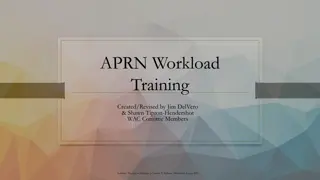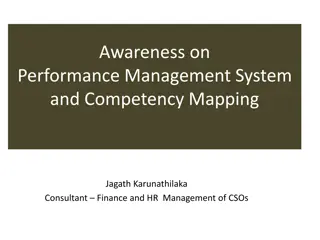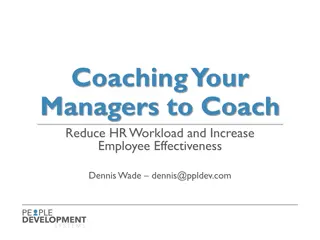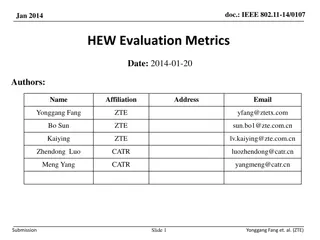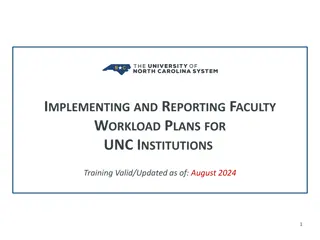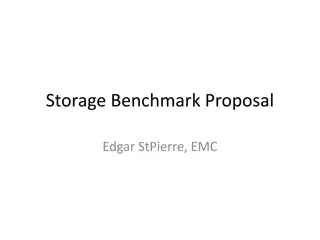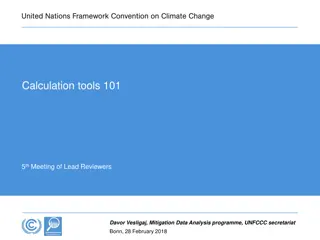New Paradigm in Workload Data for Performance Evaluation
Experimental computer science explores resampling with feedback as a method for evaluating performance using workload data. Learn how to achieve representativeness in workload evaluation and the importance of feedback in assessment results.
Download Presentation

Please find below an Image/Link to download the presentation.
The content on the website is provided AS IS for your information and personal use only. It may not be sold, licensed, or shared on other websites without obtaining consent from the author.If you encounter any issues during the download, it is possible that the publisher has removed the file from their server.
You are allowed to download the files provided on this website for personal or commercial use, subject to the condition that they are used lawfully. All files are the property of their respective owners.
The content on the website is provided AS IS for your information and personal use only. It may not be sold, licensed, or shared on other websites without obtaining consent from the author.
E N D
Presentation Transcript
Resampling with Feedback A New Paradigm of Using Workload Data for Performance Evaluation Dror Feitelson Hebrew University
Performance Evaluation Experimental computer science at its best [Denning 1981] Major element of systems research Compare design alternatives Tune parameter values Assess capacity requirements Very good when done well Very bad when not Miss missions objectives Waste of resources
Workload = Input Algorithms Worst case time/space bounds Input instance Algorithm Systems Average response-time /throughput metrics Workload System
Representativeness Average statistics matter Evaluation workload has to be representative of real production workloads Achieved by using the workloads on existing systems Analyze the workload and create a model Use workload directly to drive a simulation
A 20-Year Roller Coaster Ride Models are great Models are oversimplifications Logs are the real thing Logs are inflexible and dirty Resampling can solve many problems Provided feedback is added Image Credit: Roller Coaster from vector.me (by tzunghaor)
The JSSPP Context Job scheduling, not task scheduling Human in the loop Simulation more than analysis Minute details matter
Outline for Today Background parallel job scheduling Workload models ups and downs Using logs directly ups and downs Resampling workloads Adding feedback Examples of evaluation results
Outline for Today Background parallel job scheduling Workload models ups and downs Using logs directly ups and downs Resampling workloads Adding feedback Examples of evaluation results
Parallel Job Scheduling Each job is a rectangle in processorsXtime space Given many jobs, we must schedule them to run on available processors This is like packing the rectangles Want to minimize space used, i.e. minimize used resources and fragmentation On-line problem: don t know future arrivals or runtimes
FCFS and EASY FCFS EASY
FCFS and EASY FCFS EASY
FCFS and EASY FCFS EASY
FCFS and EASY FCFS EASY
FCFS and EASY FCFS Queued jobs EASY
FCFS and EASY FCFS Queued jobs EASY
FCFS and EASY FCFS Queued jobs backfilling EASY
FCFS and EASY FCFS Queued jobs EASY
FCFS and EASY FCFS Queued jobs EASY
Evaluation by Simulation What we just saw is a simulation of two schedulers Tabulate wait times to assess performance In this case, EASY was better It all depends on the workload In this case, combinations of long-narrow jobs So the workload needs to be representative
Workload Data Ensure representativeness by using real workloads Job arrival patterns Job resource demands (processors and runtime)
Outline for Today Background parallel job scheduling Workload models ups and downs Using logs directly ups and downs Resampling workloads Adding feedback Examples of evaluation results
Workload Modeling Identify important workload attributes Collect data (empirical distributions) Fit to mathematical distributions Used for random variate generation as input to simulations Used for selecting distributions as input to analysis Typically assume stationarity Evaluate the system is a steady state
Modeling is Great! Models embody knowledge Models allow for controlled experiments Modeled workloads have good statistical properties Models avoid problems in logs Bogus data Local limitations
Modeling is Great! Models embody knowledge Models allow for controlled experiments Modeled workloads have good statistical properties Models avoid problems in logs Bogus data Local limitations Know about distributions Know about correlations Can exploit this in designs
Modeling is Great! Models embody knowledge Models allow for controlled experiments Modeled workloads have good statistical properties Models avoid problems in logs Bogus data Local limitations Change one workload parameter at a time (e.g. load) and see its effect
Modeling is Great! Models embody knowledge Models allow for controlled experiments Modeled workloads have good statistical properties Models avoid problems in logs Bogus data Local limitations Faster convergence of results Modeled workloads are usually stationary
Modeling is Great! Models embody knowledge Models allow for controlled experiments Modeled workloads have good statistical properties Models avoid problems in logs Bogus data Local limitations Jobs that were killed Strange behaviors of individual users
Modeling is Great! Models embody knowledge Models allow for controlled experiments Modeled workloads have good statistical properties Models avoid problems in logs Bogus data Local limitations e.g. constraint that jobs are limited to 4 hours max
But Models include only what you put in them Corollary: they do not include two things: 1. What you THINK is NOT important* 2. What you DON T KNOW about You could be wrong about what is important* What you don t know might be important* * Important = affects performance results
Unexpected Importance I EASY requires user runtime estimates to plan ahead backfilling Typically assumed to be accurate They are not CTC KTH
Unexpected Importance I EASY requires user runtime estimates to plan ahead backfilling Typically assumed to be accurate They are not This may have a large effect on results Cause holes to be left in the schedule Small holes are suitable for short jobs Causes an SJF-like effect worse estimates lead to better performance Mu'alem & Feitelson, IEEE TPDS 2001; Tsafrir & Feitelson, IISWC 2006
Need to Model Estimates Models which assume accurate runtime estimates lead to overly optimistic results Need to include realistic estimates in the models Use of few discrete values Use of maximal allowed values Tsafrir, Etsion, & Feitelson, JSSPP 2005; Tsafrir JSSPP 2010
Unexpected Importance II Daily cycle of activity often ignored Focus on prime time only = most demanding load Turned out to be important in user-aware scheduler Implication: workloads are actually not stationary The system is always in a transient state Confidence intervals become meaningless
User-Aware Scheduler Prioritize jobs with short expected response times Correlated with short think times An attempt to keep users satisfied and extend user sessions This also improves system utilization and throughput Balance with job seniority to prevent starvation Shmueli & Feitelson, IEEE TPDS 2009
Performance Load is expressed as the number of active users The higher the emphasis on responsiveness, the higher the achieved utilization No weight for responsiveness is the same as EASY 90 80 70 utilization [%] 60 EASY 50 40 30 50 100 150 200 250 number of users
Daily Cycle Improved throughput depends on User behavior (leave if jobs delayed) Scheduler design (prioritize interactive jobs) Daily cycle of activity During the day, accept higher load than can be sustained Delay batch jobs During the night drain the excess jobs, using resources that would otherwise remain idle Model without daily cycle shows no improvement Feitelson & Shmueli, MASCOTS 2009
Daily Cycle Improved throughput depends on User behavior (leave if jobs delayed) Scheduler design (prioritize interactive jobs) Daily cycle of activity During the day, accept higher load than can be sustained Delay batch jobs During the night drain the excess jobs, using resources that would otherwise remain idle Model without daily cycle shows no improvement Feitelson & Shmueli, MASCOTS 2009
Unexpected Importance III Workload assumed to be a random sample from a distribution Implies stationarity Good for convergence of results Also implies no locality Statistically, nothing ever changes Cannot learn from experience Stationary model workloads cannot be used to evaluate adaptive systems
Outline for Today Background parallel job scheduling Workload models ups and downs Using logs directly ups and downs Resampling workloads Adding feedback Examples of evaluation results
Using Accounting Logs In simulations, logs can be used directly to generate the input workload Jobs arrive according to timestamps in the log Each job requires the number of processors and runtime as specified in the log Used to evaluate new scheduler designs Current best practice Includes all the structures that exist in real workloads Even if you don t know about them!
Parallel Workloads Archive All large scale supercomputers and clusters maintain accounting logs Data includes job arrival, queue time, runtime, processors, user, and more Many are willing to share them (and shame on those who are not) Collection at www.cs.huji.ac.il/labs/parallel/workload/ Uses standard format to ease use Feitelson, Tsafrir, & Krakov, JPDC 2014
Example: NASA iPSC/860 trace user user8 sysadmin pwd sysadmin pwd intel0 user2 user2 user2 user2 intel0 user2 user6 command proc runtime date cmd33 1 1 1 cmd11 64 cmd2 1 cmd2 1 nsh 0 cmd1 32 cmd11 32 cmd2 1 cmd8 32 time 31 10/19/93 18:06:10 16 10/19/93 18:06:57 5 10/19/93 18:08:27 165 10/19/93 18:11:36 19 10/19/93 18:11:59 11 10/19/93 18:12:28 10 10/19/93 18:16:23 2482 10/19/93 18:16:37 221 10/19/93 18:20:12 11 10/19/93 18:23:47 167 10/19/93 18:30:45
Usage Growing usage of the PWA About 100 papers a year More than 1500 cumulative
But Logs provide only a single data point Logs are inflexible Can t adjust to different system configurations Can t change parameters to see their effect Logs may require cleaning Logs are actually unsuitable for evaluating diverse systems Contain a signature of the original system
Beware Dirty Data Using real data is important But is ALL real data worth using? Errors in data recording Evolution and non-stationarity Diversity between different sources Multi-class mixtures Abnormal activity Need to select relevant data source Need to clean dirty data
Abnormality Example Some users are much more active than others So much so that they single-handedly affect workload statistics Job arrivals (more) Job sizes (modal?) Probably not generally representative Are we optimizing the system for user #2? HPC2N cluster 20000 18000 user 2 257 others 16000 14000 jobs per week 12000 10000 8000 6000 4000 2000 0 28/07/2002 02/07/2004 21/08/2005
Workload Flurries Bursts of activity by a single user Lots of jobs All these jobs are small All of them have similar characteristics Limited duration (day to weeks) Flurry jobs may be affected as a group, leading to potential instability (butterfly effect) This is a problem with evaluation methodology more than with real systems Tsafrir & Feitelson, IPDPS 2006
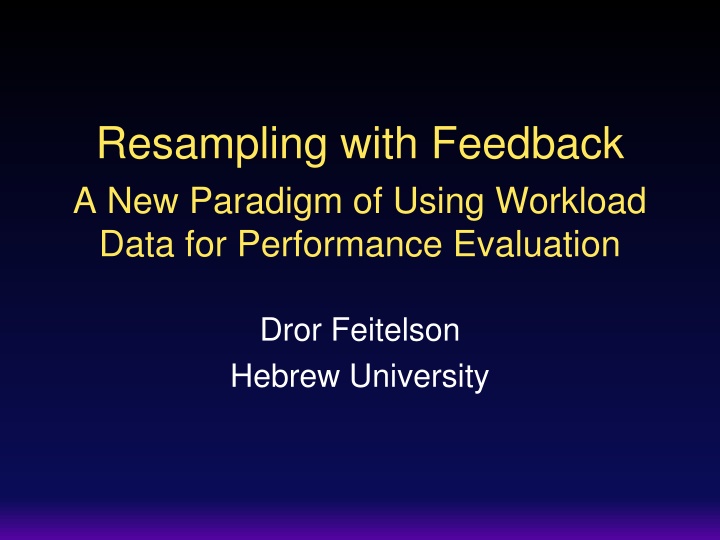


![[PDF⚡READ❤ONLINE] Black Hole Astrophysics: The Engine Paradigm (Springer Praxis](/thumb/21503/pdf-read-online-black-hole-astrophysics-the-engine-paradigm-springer-praxis.jpg)
